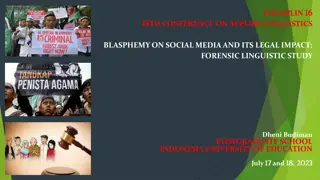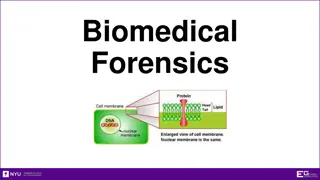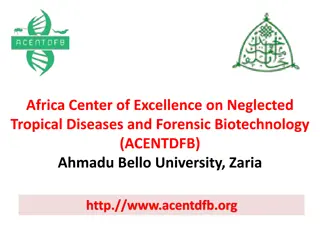Exploring Questioned Documents in Forensic Science
Explore the world of questioned documents in forensic science, understanding what they are and their significance in investigations. Delve into the history of document examination, handwriting analysis, collection of writing standards, and the process of handwriting comparison. Learn about the unique characteristics of handwriting and the meticulous approach taken by document examiners in analyzing and comparing documents.
Download Presentation

Please find below an Image/Link to download the presentation.
The content on the website is provided AS IS for your information and personal use only. It may not be sold, licensed, or shared on other websites without obtaining consent from the author. Download presentation by click this link. If you encounter any issues during the download, it is possible that the publisher has removed the file from their server.
E N D
Presentation Transcript
Chapter 21 QUESTIONED DOCUMENTS QUESTIONED DOCUMENTS
Answer= #5 Answer= #5
I. What is a questioned document = one that is entirely or in part suspect as to the authenticity or origin Examples: Commonly think of checks, wills, and contracts Also include typewritten letter, dollar bill, postage stamps, receipts, concert tickets, etc.
II. History of role in forensic science The field of questioned documents = one of the oldest in forensic science Albert S. Osborn= pioneer of the field Lindbergh baby kidnapping case = important in establishing to the legal system the role of document examiner (ransom note) Now . . . --document examiner must always be prepared to state opinion in court and demonstrate how formed opinion --beyond college one needs on-the-job training/internship before become document examiner and then keep up with latest in the field
III. Handwriting analysis A. Theory of handwriting No two people have the same handwriting . . .why? 1. Neuromuscular coordination and visual perception differ between people 2. By time teenager, writing matured and has a unique style KEY= Handwriting is an acquired skill that becomes ingrained; it is habitual and individualized.
B. Collection of Writing Standards Before can begin examination, must collect writing standard . . . two types 1. Non-request writing= spontaneous or undictated + reveal most normal habits - difficult to obtain enough comparable letters and words 2. Request writing= dictated + provide writing comparable to questioned material - call attention to the writing process (nervousness and/or try to disguise own writing)
C. Process of handwriting comparison 1. Visually and microscopically compare questioned document and known standards side-by-side Two principles of comparison 1--No two individuals write exactly alike 2--No one person writes exactly the same way twice Keep in mind . . . an individual has a repetitive range to his/her writing and basic pattern or habitual style is still present
3. What experts look for???? Experts examine . . . . class (features and dimensions of letters) and . . . .individual characteristics (unique features of the letters)
12 Characteristics of handwriting = line quality spacing of words and letters ratio of height, width, and size of letters pen lifts and separations connecting strokes beginning and ending strokes unusual letter formations shading or pen pressure slant 1. 2. 3. 4. 5. 6. 7. 8. 9. 10. baseline habits 11. flourishes or embellishments 12. placement of diacritics
IV. Methods of Forgery Three types: 1. Blind forgery or normal hand forgery = forger does not attempt to copy victims writing . . . writes in own writing style or tries to disguise it --most common --easiest to detect
2. Simulated forgery = attempting to copy the victims writing style --working off of model signature --must maintain speed, correct letter formations, height ratio, and pen pressure all at same time --must also suppress own writing habits --not hard to detect as forgery, but can be difficult to link to suspect
3. Traced forgery/Tracing = using original as a guide --detected due to inconsistent line quality (i.e. shaky and slow) --detected by indentation mark (oblique lighting or ESDA) -ESDA = electrostatic detection apparatus http://www.alzomar.com/page.asp?page=Documents
Primary signs of forgery = 1. The appearance of being written slowly 2. Blunt line endings and beginnings 3. Poor line quality with wavering and tremors of the line 4. Retracing and patching 5. Stops in places where writing should be free and smooth 6. Inconsistent letter formation NOTE: Software (CEDAR) available to assist in handwriting analysis . . . but cannot eliminate examiner b/c detail only detected by human eye.
V. Typewriting Examination Evidence submission --need typewriter in question or a sample from that typewriter Examination --typewriter make and model can be determined --the older the machine, the better the possibility for identification --identify through: type alignment, spacing, broken or damage font, ink density, and pressure
VI. Photocopy Examination Detect trash marks --include: debris, gripper marks, platen defects, and dirt on copier Copier make and model may be detected Material can be dated as these qualities can change over time Photocopy forgery --Detect: misaligned typing, different fonts or font sizes, incorrect margins, shadowing at jointed areas, and trash marks
VII. Obliterations Methods = 1. Erase or scrape ink off surface 2. Use chemicals to make ink become colorless (ex. Chlorine or sodium hypochlorite) Detection = Microscopic examination Infrared or UV light
VIII. Alterations and Ink Detection = Microscopic examination Infrared or UV light (different inks react differently to this light) TLC (Thin Layer Chromatography) --destructive test but definitive results --use small punches from document in question --results in bands of color up a piece of paper --comparing bands can indicate if inks from same source
IX. Paper Examination necessary when questions about whether pages added to multi-page document. Examine: --staple marks --paper composition: usually wood or cotton with certain fillers added -chemical testing can detect materials present and associate with both a known standard and a manufacturer --paper size and thickness -line up in stack (small differences) -micrometers used to detect thickness --watermark (clues about manufacturer)























